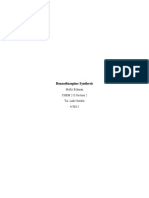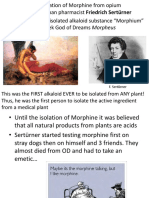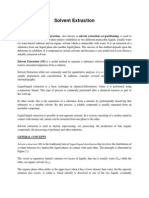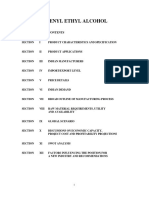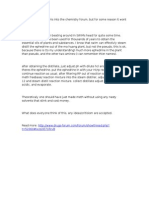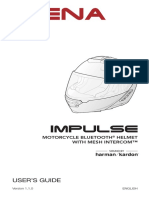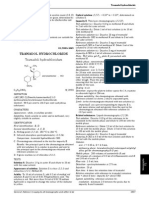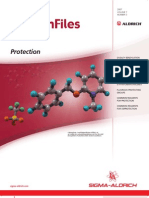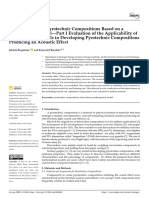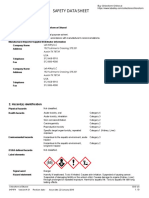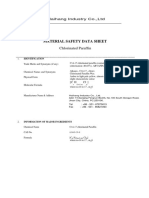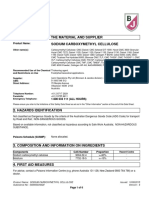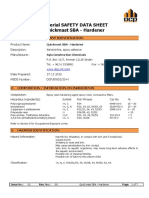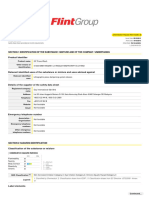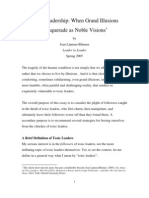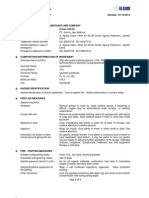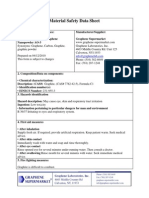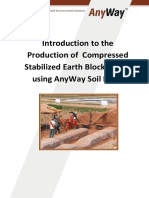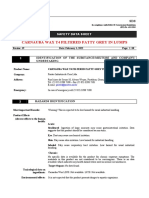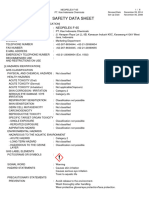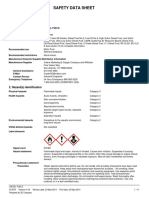SAFETY DATA SHEET
Creation Date 20-Jan-2010 Revision Date 25-Apr-2019 Revision Number 5
1. Identification
Product Name Chloroform, stabilized with ethanol
Cat No. : C606-1; C606-1EA; C606-4; C606RS-28; C606RS-115; C606SK-1;
C606SK-4; C606SS-28; C606SS-50; C606SS-115; C606SS-200
CAS-No 67-66-3
Synonyms Formyl trichloride; Methane trichloride; Methenyl trichloride
Recommended Use Laboratory chemicals.
Uses advised against
Details of the supplier of the safety data sheet
Company
Fisher Scientific
One Reagent Lane
Fair Lawn, NJ 07410
Tel: (201) 796-7100
Emergency Telephone Number
CHEMTRECÒ, Inside the USA: 800-424-9300
CHEMTRECÒ, Outside the USA: 001-703-527-3887
2. Hazard(s) identification
Classification
This chemical is considered hazardous by the 2012 OSHA Hazard Communication Standard (29 CFR 1910.1200)
Acute oral toxicity Category 4
Acute Inhalation Toxicity - Vapors Category 3
Skin Corrosion/irritation Category 2
Serious Eye Damage/Eye Irritation Category 2
Carcinogenicity Category 2
Reproductive Toxicity Category 2
Specific target organ toxicity (single exposure) Category 3
Target Organs - Respiratory system, Central nervous system (CNS).
Specific target organ toxicity - (repeated exposure) Category 2
Target Organs - Heart, Liver, Kidney, Blood.
Label Elements
Signal Word
Danger
Hazard Statements
______________________________________________________________________________________________
Page 1 / 9
�Chloroform, stabilized with ethanol Revision Date 25-Apr-2019
______________________________________________________________________________________________
Harmful if swallowed
Causes skin irritation
Causes serious eye irritation
Toxic if inhaled
May cause respiratory irritation
May cause drowsiness or dizziness
Suspected of causing cancer
Suspected of damaging the unborn child
May cause damage to organs through prolonged or repeated exposure
Precautionary Statements
Prevention
Obtain special instructions before use
Do not handle until all safety precautions have been read and understood
Use personal protective equipment as required
Wash face, hands and any exposed skin thoroughly after handling
Do not eat, drink or smoke when using this product
Use only outdoors or in a well-ventilated area
Wear eye/face protection
Do not breathe dust/fume/gas/mist/vapors/spray
Response
IF exposed or concerned: Get medical attention/advice
Inhalation
IF INHALED: Remove victim to fresh air and keep at rest in a position comfortable for breathing
Skin
IF ON SKIN: Wash with plenty of soap and water
If skin irritation occurs: Get medical advice/attention
Take off contaminated clothing and wash before reuse
Eyes
IF IN EYES: Rinse cautiously with water for several minutes. Remove contact lenses, if present and easy to do. Continue rinsing
If eye irritation persists: Get medical advice/attention
Ingestion
IF SWALLOWED: Call a POISON CENTER or doctor/physician if you feel unwell
Rinse mouth
Storage
Store locked up
Store in a well-ventilated place. Keep container tightly closed
Disposal
Dispose of contents/container to an approved waste disposal plant
Hazards not otherwise classified (HNOC)
WARNING. Cancer - https://www.p65warnings.ca.gov/.
3. Composition/Information on Ingredients
Component CAS-No Weight %
Chloroform 67-66-3 >99
Ethyl alcohol 64-17-5 <0.8
4. First-aid measures
______________________________________________________________________________________________
Page 2 / 9
�Chloroform, stabilized with ethanol Revision Date 25-Apr-2019
______________________________________________________________________________________________
General Advice Show this safety data sheet to the doctor in attendance. Immediate medical attention is
required.
Eye Contact Rinse immediately with plenty of water, also under the eyelids, for at least 15 minutes. In
the case of contact with eyes, rinse immediately with plenty of water and seek medical
advice.
Skin Contact Wash off immediately with plenty of water for at least 15 minutes. Immediate medical
attention is required.
Inhalation Move to fresh air. If not breathing, give artificial respiration. Do not use mouth-to-mouth
method if victim ingested or inhaled the substance; give artificial respiration with the aid of a
pocket mask equipped with a one-way valve or other proper respiratory medical device.
Immediate medical attention is required.
Ingestion Do not induce vomiting. Call a physician or Poison Control Center immediately.
Most important symptoms and . Symptoms of overexposure are dizziness, headache, tiredness, nausea,
effects unconsciousness, cessation of breathing: May cause decreases in blood pressure and
other cardiac effects: Symptoms may be delayed
Notes to Physician Treat symptomatically
5. Fire-fighting measures
Suitable Extinguishing Media Substance is nonflammable; use agent most appropriate to extinguish surrounding fire.
Unsuitable Extinguishing Media No information available
Flash Point No information available
Method - No information available
Autoignition Temperature No information available
Explosion Limits
Upper No data available
Lower No data available
Sensitivity to Mechanical Impact No information available
Sensitivity to Static Discharge No information available
Specific Hazards Arising from the Chemical
Non-combustible, substance itself does not burn but may decompose upon heating to produce corrosive and/or toxic fumes.
Hazardous Combustion Products
Carbon monoxide (CO) Carbon dioxide (CO2) Hydrogen chloride gas phosgene
Protective Equipment and Precautions for Firefighters
As in any fire, wear self-contained breathing apparatus pressure-demand, MSHA/NIOSH (approved or equivalent) and full
protective gear. Thermal decomposition can lead to release of irritating gases and vapors.
NFPA
Health Flammability Instability Physical hazards
2 1 1 N/A
6. Accidental release measures
Personal Precautions Ensure adequate ventilation. Use personal protective equipment. Keep people away from
and upwind of spill/leak. Evacuate personnel to safe areas.
Environmental Precautions Should not be released into the environment.
Methods for Containment and Clean Soak up with inert absorbent material. Keep in suitable, closed containers for disposal.
Up
______________________________________________________________________________________________
Page 3 / 9
�Chloroform, stabilized with ethanol Revision Date 25-Apr-2019
______________________________________________________________________________________________
7. Handling and storage
Handling Wear personal protective equipment. Do not get in eyes, on skin, or on clothing. Use only
under a chemical fume hood. Do not breathe vapors or spray mist. Do not ingest.
Storage Keep containers tightly closed in a dry, cool and well-ventilated place. Keep away from
direct sunlight. Store under an inert atmosphere. Protect from moisture.
8. Exposure controls / personal protection
Exposure Guidelines
Component ACGIH TLV OSHA PEL NIOSH IDLH Mexico OEL (TWA)
Chloroform TWA: 10 ppm (Vacated) TWA: 2 ppm IDLH: 500 ppm TWA: 10 ppm
(Vacated) TWA: 9.78 mg/m3 STEL: 2 ppm TWA: 50 mg/m3
Ceiling: 50 ppm STEL: 9.78 mg/m3 STEL: 50 ppm
Ceiling: 240 mg/m3 STEL: 225 mg/m3
Ethyl alcohol STEL: 1000 ppm (Vacated) TWA: 1000 ppm IDLH: 3300 ppm STEL: 1000 ppm
(Vacated) TWA: 1900 mg/m3 TWA: 1000 ppm
TWA: 1000 ppm TWA: 1900 mg/m3
TWA: 1900 mg/m3
Legend
ACGIH - American Conference of Governmental Industrial Hygienists
OSHA - Occupational Safety and Health Administration
NIOSH IDLH: The National Institute for Occupational Safety and Health Immediately Dangerous to Life or Health
Engineering Measures Use only under a chemical fume hood. Ensure adequate ventilation, especially in confined
areas. Ensure that eyewash stations and safety showers are close to the workstation
location.
Personal Protective Equipment
Eye/face Protection Wear appropriate protective eyeglasses or chemical safety goggles as described by
OSHA's eye and face protection regulations in 29 CFR 1910.133 or European Standard
EN166. Tightly fitting safety goggles. Face-shield.
Skin and body protection Long sleeved clothing.
Respiratory Protection Follow the OSHA respirator regulations found in 29 CFR 1910.134 or European Standard
EN 149. Use a NIOSH/MSHA or European Standard EN 149 approved respirator if
exposure limits are exceeded or if irritation or other symptoms are experienced.
Hygiene Measures Handle in accordance with good industrial hygiene and safety practice.
9. Physical and chemical properties
Physical State Liquid
Appearance Colorless
Odor aromatic Slight sweet
Odor Threshold No information available
pH No information available
Melting Point/Range -63 °C / -81.4 °F
Boiling Point/Range 61 °C / 141.8 142.7 °F
Flash Point No information available
Evaporation Rate 11.6 (Butyl Acetate = 1.0)
Flammability (solid,gas) Not applicable
Flammability or explosive limits
Upper No data available
______________________________________________________________________________________________
Page 4 / 9
�Chloroform, stabilized with ethanol Revision Date 25-Apr-2019
______________________________________________________________________________________________
Lower No data available
Vapor Pressure 213 mbar @ 20 °C
Vapor Density 4.12 (Air = 1.0)
Specific Gravity 1.480
Solubility Slightly soluble in water
Partition coefficient; n-octanol/water No data available
Autoignition Temperature No information available
Decomposition Temperature No information available
Viscosity 0.56 mPa.s @ 20 °C
Molecular Formula C H Cl3
Molecular Weight 119.38
10. Stability and reactivity
Reactive Hazard None known, based on information available
Stability Stable under normal conditions. Unstable upon depletion of inhibitor. Light sensitive.
Conditions to Avoid Incompatible products. Heat, flames and sparks. Excess heat. Exposure to light. Protect
from moisture.
Incompatible Materials Strong oxidizing agents, Alkali metals, Aluminium, Acetone
Hazardous Decomposition Products Carbon monoxide (CO), Carbon dioxide (CO2), Hydrogen chloride gas, phosgene
Hazardous Polymerization Hazardous polymerization does not occur.
Hazardous Reactions None under normal processing.
11. Toxicological information
Acute Toxicity
Product Information
Component Information
Component LD50 Oral LD50 Dermal LC50 Inhalation
Chloroform LD50 = 695 mg/kg ( Rat ) LD50 > 20 g/kg ( Rabbit ) 47,702 mg/L ( Rat ) 4 h
LD50 = 450 mg/kg ( Rat )
Ethyl alcohol 3450 mg/kg ( Mouse ) Not listed 20000 ppm/10H ( Rat )
Toxicologically Synergistic No information available
Products
Delayed and immediate effects as well as chronic effects from short and long-term exposure
Irritation Irritating to eyes and skin
Sensitization No information available
Carcinogenicity The table below indicates whether each agency has listed any ingredient as a carcinogen.
Limited evidence of a carcinogenic effect. Ethanol has been shown to be carcinogenic in
long-term studies only when consumed and abused as an alcoholic beverage.
Component CAS-No IARC NTP ACGIH OSHA Mexico
Chloroform 67-66-3 Group 2B Reasonably A3 X A3
Anticipated
Ethyl alcohol 64-17-5 Group 1 Known A3 X A3
IARC: (International Agency for Research on Cancer) IARC: (International Agency for Research on Cancer)
Group 1 - Carcinogenic to Humans
Group 2A - Probably Carcinogenic to Humans
Group 2B - Possibly Carcinogenic to Humans
NTP: (National Toxicity Program) NTP: (National Toxicity Program)
Known - Known Carcinogen
______________________________________________________________________________________________
Page 5 / 9
�Chloroform, stabilized with ethanol Revision Date 25-Apr-2019
______________________________________________________________________________________________
Reasonably Anticipated - Reasonably Anticipated to be a Human
Carcinogen
ACGIH: (American Conference of Governmental Industrial A1 - Known Human Carcinogen
Hygienists) A2 - Suspected Human Carcinogen
A3 - Animal Carcinogen
ACGIH: (American Conference of Governmental Industrial Hygienists)
Mexico - Occupational Exposure Limits - Carcinogens Mexico - Occupational Exposure Limits - Carcinogens
A1 - Confirmed Human Carcinogen
A2 - Suspected Human Carcinogen
A3 - Confirmed Animal Carcinogen
A4 - Not Classifiable as a Human Carcinogen
A5 - Not Suspected as a Human Carcinogen
Mutagenic Effects No information available
Reproductive Effects Suspect reproductive hazard - contains material which may injure unborn child.
Developmental Effects No information available.
Teratogenicity No information available.
STOT - single exposure Respiratory system Central nervous system (CNS)
STOT - repeated exposure Heart Liver Kidney Blood
Aspiration hazard No information available
Symptoms / effects,both acute and Symptoms of overexposure are dizziness, headache, tiredness, nausea, unconsciousness,
delayed cessation of breathing: May cause decreases in blood pressure and other cardiac effects:
Symptoms may be delayed
Endocrine Disruptor Information No information available
Other Adverse Effects Tumorigenic effects have been reported in experimental animals. See actual entry in
RTECS for complete information.
12. Ecological information
Ecotoxicity
Do not empty into drains. Harmful to aquatic organisms, may cause long-term adverse effects in the aquatic environment. The
product contains following substances which are hazardous for the environment.
Component Freshwater Algae Freshwater Fish Microtox Water Flea
Chloroform EC50 = 560 mg/L/48h LC50: = 300 mg/L, 96h static Photobacterium EC50 = 28.9 mg/L/48h
(Poecilia reticulata) phosphoreum: EC50 = 520
LC50: = 18 mg/L, 96h mg/L/5 min
flow-through (Lepomis Photobacterium
macrochirus) phosphoreum: EC50 = 670
LC50: = 18 mg/L, 96h mg/L/15 min
flow-through (Oncorhynchus Photobacterium
mykiss) phosphoreum: EC50 = 670
LC50: = 71 mg/L, 96h mg/L/30min
flow-through (Pimephales
promelas)
Ethyl alcohol EC50 (72h) = 275 mg/l Fathead minnow Photobacterium EC50 = 9268 mg/L/48h
(Chlorella vulgaris) (Pimephales promelas) phosphoreum:EC50 = 34634 EC50 = 10800 mg/L/24h
LC50 = 14200 mg/l/96h mg/L/30 min
Photobacterium
phosphoreum:EC50 = 35470
mg/L/5 min
Persistence and Degradability Persistence is unlikely based on information available.
Bioaccumulation/ Accumulation No information available.
Mobility Will likely be mobile in the environment due to its volatility.
______________________________________________________________________________________________
Page 6 / 9
�Chloroform, stabilized with ethanol Revision Date 25-Apr-2019
______________________________________________________________________________________________
Component log Pow
Chloroform 2
Ethyl alcohol -0.32
13. Disposal considerations
Waste Disposal Methods Chemical waste generators must determine whether a discarded chemical is classified as a
hazardous waste. Chemical waste generators must also consult local, regional, and
national hazardous waste regulations to ensure complete and accurate classification.
Component RCRA - U Series Wastes RCRA - P Series Wastes
Chloroform - 67-66-3 U044 -
14. Transport information
DOT
UN-No UN1888
Proper Shipping Name CHLOROFORM
Hazard Class 6.1
Packing Group III
TDG
UN-No UN1888
Proper Shipping Name CHLOROFORM
Hazard Class 6.1
Packing Group III
IATA
UN-No UN1888
Proper Shipping Name CHLOROFORM
Hazard Class 6.1
Packing Group III
IMDG/IMO
UN-No UN1888
Proper Shipping Name CHLOROFORM
Hazard Class 6.1
Packing Group III
15. Regulatory information
United States of America Inventory
Component CAS-No TSCA TSCA Inventory notification - TSCA - EPA Regulatory
Active/Inactive Flags
Chloroform 67-66-3 X ACTIVE -
Ethyl alcohol 64-17-5 X ACTIVE -
Legend:
TSCA - Toxic Substances Control Act, (40 CFR Part 710)
X - Listed
'-' - Not Listed
TSCA 12(b) - Notices of Export Not applicable
International Inventories
Canada (DSL/NDSL), Europe (EINECS/ELINCS/NLP), Philippines (PICCS), Japan (ENCS), Australia (AICS), China (IECSC), Korea (ECL).
Component CAS-No DSL NDSL EINECS PICCS ENCS AICS IECSC KECL
Chloroform 67-66-3 X - 200-663-8 X X X X X
Ethyl alcohol 64-17-5 X - 200-578-6 X X X X KE-13217
U.S. Federal Regulations
______________________________________________________________________________________________
Page 7 / 9
�Chloroform, stabilized with ethanol Revision Date 25-Apr-2019
______________________________________________________________________________________________
SARA 313
Component CAS-No Weight % SARA 313 - Threshold
Values %
Chloroform 67-66-3 >99 0.1
SARA 311/312 Hazard Categories See section 2 for more information
CWA (Clean Water Act)
Component CWA - Hazardous CWA - Reportable CWA - Toxic Pollutants CWA - Priority Pollutants
Substances Quantities
Chloroform X 10 lb X X
Clean Air Act
Component HAPS Data Class 1 Ozone Depletors Class 2 Ozone Depletors
Chloroform X -
OSHA - Occupational Safety and Not applicable
Health Administration
CERCLA This material, as supplied, contains one or more substances regulated as a hazardous
substance under the Comprehensive Environmental Response Compensation and Liability
Act (CERCLA) (40 CFR 302)
Component Hazardous Substances RQs CERCLA EHS RQs
Chloroform 10 lb 1 lb 10 lb
California Proposition 65 This product contains the following proposition 65 chemicals
Component CAS-No California Prop. 65 Prop 65 NSRL Category
Chloroform 67-66-3 Carcinogen 20 µg/day Developmental
Developmental 40 µg/day Carcinogen
Ethyl alcohol 64-17-5 Development (alcoholic - Developmental
beverages only) Carcinogen
U.S. State Right-to-Know
Regulations
Component Massachusetts New Jersey Pennsylvania Illinois Rhode Island
Chloroform X X X X X
Ethyl alcohol X X X X X
U.S. Department of Transportation
Reportable Quantity (RQ): Y
DOT Marine Pollutant N
DOT Severe Marine Pollutant N
U.S. Department of Homeland This product contains the following DHS chemicals:
Security Legend - STQs = Screening Threshold Quantities, APA = A placarded amount
Component DHS Chemical Facility Anti-Terrorism Standard
Chloroform Release STQs - 20000lb
Other International Regulations
Mexico - Grade No information available
16. Other information
Prepared By Regulatory Affairs
Thermo Fisher Scientific
Email: EMSDS.RA@thermofisher.com
______________________________________________________________________________________________
Page 8 / 9
�Chloroform, stabilized with ethanol Revision Date 25-Apr-2019
______________________________________________________________________________________________
Creation Date 20-Jan-2010
Revision Date 25-Apr-2019
Print Date 25-Apr-2019
Revision Summary This document has been updated to comply with the US OSHA HazCom 2012 Standard
replacing the current legislation under 29 CFR 1910.1200 to align with the Globally
Harmonized System of Classification and Labeling of Chemicals (GHS).
Disclaimer
The information provided in this Safety Data Sheet is correct to the best of our knowledge, information and belief at the
date of its publication. The information given is designed only as a guidance for safe handling, use, processing, storage,
transportation, disposal and release and is not to be considered a warranty or quality specification. The information
relates only to the specific material designated and may not be valid for such material used in combination with any other
materials or in any process, unless specified in the text
End of SDS
______________________________________________________________________________________________
Page 9 / 9
